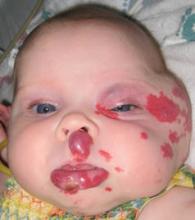PASADENA, CALIF. - Recent enthusiasm for treating hemangiomas with propranolol has been tempered by reports of life-threatening events in three infants.
"We're wrestling with the propranolol issue in our practice now. There has to be a significant amount of counseling" of patients and their families while clinicians figure out the safest protocols for propranolol use, Dr. Lawrence F. Eichenfield said at the meeting.
The propranolol-for-hemangiomas story started several years ago when French physicians prescribed high-dose prednisolone for severe hemangiomas in four infants, noticed they were developing high blood pressure secondary to the corticosteroid, and put them on a beta-blocker for the high blood pressure. After a few days of beta-blocker therapy, the hemangiomas started disappearing at a much faster rate than they had on the corticosteroid alone.
The physicians then went directly to propranolol therapy for severe hemangiomas in seven more infants, bypassing the corticosteroid. On a dose of 2-3 mg/kg per day, "they saw a similar incredible response to their hemangiomas," with softening and change in color from red to purple noted in all infants at 24 hours, Dr. Eichenfield said (N. Engl. J. Med. 2008;358:2649-51).
The French series expanded to 32 children with severe hemangiomas at a mean age of 4 months, and therapeutic effects were seen in all cases, with a mean treatment duration of 6 months (Pediatrics 2009;124:e423-31).
"Now, there are at least 50 articles in the literature in the past 9 months about propranolol, as it expands from the pediatric dermatology hands to others around the world," said Dr. Eichenfield, director of pediatric and adolescent dermatology at Rady Children's Hospital, San Diego. "It’s an incredible drug, but not without its issues."
The most alarming issues appear to be idiosyncratic events with hypotension, hypoglycemia, hypothermia, bradycardia, or asthma exacerbation. Three children developed life-threatening reactions (Arch. Dermatol. 2010;146:775-8).
The first case was an 11-month-old with a periocular hemangioma who titrated up on propranolol dosing for 2 weeks and had been on a stable dose of propranolol for 3 weeks. The infant was a little fussy one night, got a propranolol dose the next morning, and 2 hours later was pale, cold, clammy, and unresponsive. After resuscitation at a hospital, the child was reported to be doing well.
The second case was an 18-month-old with a hemangioma on the nasal tip who had been on a very low dose of propranolol (1.25 mg/kg) for months. Because of a slight respiratory infection, the propranolol was withheld and restarted at a 6 p.m. dosing when the child got better. Thirteen hours later the child was found cold, clammy, and unresponsive. He had a 10-minute seizure and a second seizure on the way to the hospital, where he was found to have a serum glucose of 24 mg/dL. He responded to resuscitation.
In the third case, another child with a nasal tip hemangioma had been on 2 mg/kg per day of propranolol for 8.5 months. Two and a half hours after a breakfast dose, the child was found limp, pale, and tachypneic, and was taken to a hospital, where respiratory syncytial virus infection was diagnosed.
It's not clear what precipitated these crises, Dr. Eichenfield said. And not much is known about how best to use the drug for hemangiomas or how it works for this indication. Even in children whose hemangiomas do not respond to corticosteroids, propranolol often can produce "an incredible clinical response," he said. "You really get them down to essentially nothing very early on. We're quite pleased with those results."
Propranolol has a long history of use in children with heart disease, but not for hemangiomas.
Some physicians admit children who are initiating propranolol for hemangioma treatment, others treat on an outpatient basis. At Dr. Eichenfield's institution, they admit children who are starting the drug in the first 3 months of life, but treat others as outpatients.
The conventional dose is 2-3 mg/kg per day, but it's unclear if there's a dose response, and if patients may do better on 3 mg/kg per day than on the lower dose. Probably half of physicians prescribe a t.i.d. dosage, and others use b.i.d., he said.
It's unclear how long treatment is needed, but "there’s no question that we can get a rebound with propranolol" if the drug is stopped, he said.
Physicians who treat hemangiomas with propranolol should have a clear protocol, Dr. Eichenfield advised. "We'll share our written protocol" with physicians who request it, he said. Dermatologists should collaborate with a pediatrician and possibly a cardiologist on these cases, he added. Written materials for the patients' families and pediatricians can be helpful.




